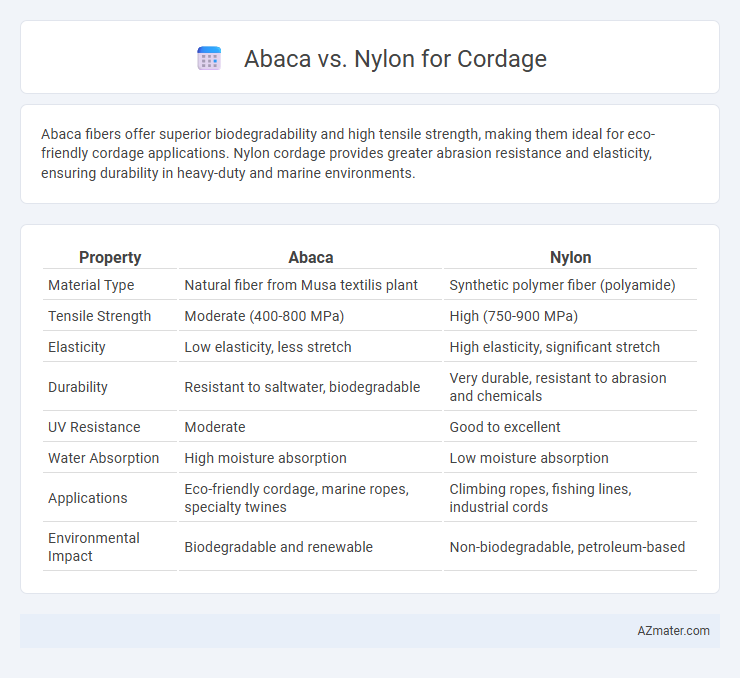Abaca fibers offer superior biodegradability and high tensile strength, making them ideal for eco-friendly cordage applications. Nylon cordage provides greater abrasion resistance and elasticity, ensuring durability in heavy-duty and marine environments.
Table of Comparison
| Property | Abaca | Nylon |
|---|---|---|
| Material Type | Natural fiber from Musa textilis plant | Synthetic polymer fiber (polyamide) |
| Tensile Strength | Moderate (400-800 MPa) | High (750-900 MPa) |
| Elasticity | Low elasticity, less stretch | High elasticity, significant stretch |
| Durability | Resistant to saltwater, biodegradable | Very durable, resistant to abrasion and chemicals |
| UV Resistance | Moderate | Good to excellent |
| Water Absorption | High moisture absorption | Low moisture absorption |
| Applications | Eco-friendly cordage, marine ropes, specialty twines | Climbing ropes, fishing lines, industrial cords |
| Environmental Impact | Biodegradable and renewable | Non-biodegradable, petroleum-based |
Introduction to Abaca and Nylon Cordage
Abaca cordage, derived from the Musa textilis plant, offers exceptional strength, biodegradability, and resistance to saltwater, making it ideal for marine applications and eco-friendly uses. Nylon cordage, a synthetic polymer known for its superior elasticity, high tensile strength, and abrasion resistance, provides durability and shock absorption in industrial and climbing applications. Both materials serve distinct purposes, with abaca favored for environmental sustainability and nylon valued for performance under dynamic loads.
Historical Overview of Cordage Materials
Abaca, derived from the Manila hemp plant, has been used for centuries in traditional rope-making due to its natural strength, flexibility, and resistance to saltwater corrosion, making it ideal for maritime applications before the industrial era. Nylon, introduced in the 20th century as a synthetic alternative, revolutionized cordage production with superior tensile strength, elasticity, and durability, especially under varying environmental conditions. The historical transition from natural fibers like abaca to synthetic materials such as nylon marked a significant advancement in rope technology, enabling enhanced performance and longer lifespan in diverse industries.
Abaca Fiber: Source and Properties
Abaca fiber, derived from the Musa textilis plant native to the Philippines, is a natural fiber prized for its exceptional strength, flexibility, and resistance to saltwater damage, making it ideal for marine and industrial cordage. Its coarse texture and high tensile strength surpass many synthetic alternatives, offering excellent durability and biodegradability. Unlike nylon, abaca fiber is eco-friendly, sustainable, and provides superior grip and abrasion resistance in rope applications.
Nylon Fiber: Source and Properties
Nylon fiber, derived from synthetic polymers such as polyamide, is widely used in cordage due to its exceptional strength, elasticity, and abrasion resistance. Unlike abaca, a natural fiber harvested from the Musa textilis plant native to the Philippines, nylon offers superior durability and resistance to moisture and chemicals, making it ideal for marine and industrial applications. Its consistent quality and versatility contribute to its preference over natural fibers in high-performance ropes and cords.
Strength and Durability Comparison
Abaca fiber, derived from the banana plant, offers high tensile strength and natural resistance to saltwater degradation, making it ideal for marine cordage applications. Nylon cordage exhibits superior elasticity and abrasion resistance, enabling it to absorb shock loads without snapping, which enhances overall durability in dynamic environments. Comparing both, nylon outperforms abaca in durability under repeated stress, while abaca provides eco-friendly strength with notable biodegradability.
Environmental Impact: Abaca vs Nylon
Abaca fiber, derived from the Musa textilis plant, is biodegradable and sustainably harvested, making it an eco-friendly choice for cordage with minimal environmental impact. Nylon, a synthetic polymer, relies on petroleum-based resources and involves energy-intensive production processes that contribute to greenhouse gas emissions and pollution. Choosing abaca over nylon significantly reduces plastic waste and supports sustainable agriculture while ensuring strong, durable rope applications.
Flexibility and Handling Characteristics
Abaca fibers offer superior flexibility and a natural grip, making them ideal for applications requiring easy knotting and handling. Nylon cordage provides exceptional elasticity and smoothness, enhancing durability and reducing hand fatigue during prolonged use. The choice between abaca and nylon cordage depends on the required balance of natural texture and synthetic resilience for specific handling needs.
Cost and Availability Analysis
Abaca fiber, derived from the Musa textilis plant, is generally more expensive than nylon due to its labor-intensive harvesting and limited geographic cultivation primarily in the Philippines. Nylon, a synthetic polymer widely produced globally, offers greater availability and lower cost because of mass manufacturing and consistent supply chains. Cost analysis reveals nylon cordage typically outperforms abaca in affordability and accessibility, making it the preferred choice in large-scale industrial applications.
Best Applications for Abaca Cordage
Abaca cordage excels in marine and agricultural applications due to its superior resistance to saltwater and biodegradability, making it ideal for ropes, twines, and sacks in eco-conscious industries. Its natural fibers offer excellent grip and knot-holding capabilities, preferred in traditional fishing nets and landscaping uses where environmental impact is a concern. Unlike nylon, abaca does not stretch significantly, providing consistent tension and durability in static load scenarios.
Best Applications for Nylon Cordage
Nylon cordage excels in applications requiring high tensile strength, elasticity, and resistance to abrasion, making it ideal for marine ropes, climbing gear, and towing lines. Its ability to absorb shock loads and resist mildew enhances performance in environments exposed to moisture and heavy wear. Compared to abaca, nylon offers superior durability and flexibility, which is crucial for safety-critical and heavy-duty uses.

Infographic: Abaca vs Nylon for Cordage
 azmater.com
azmater.com